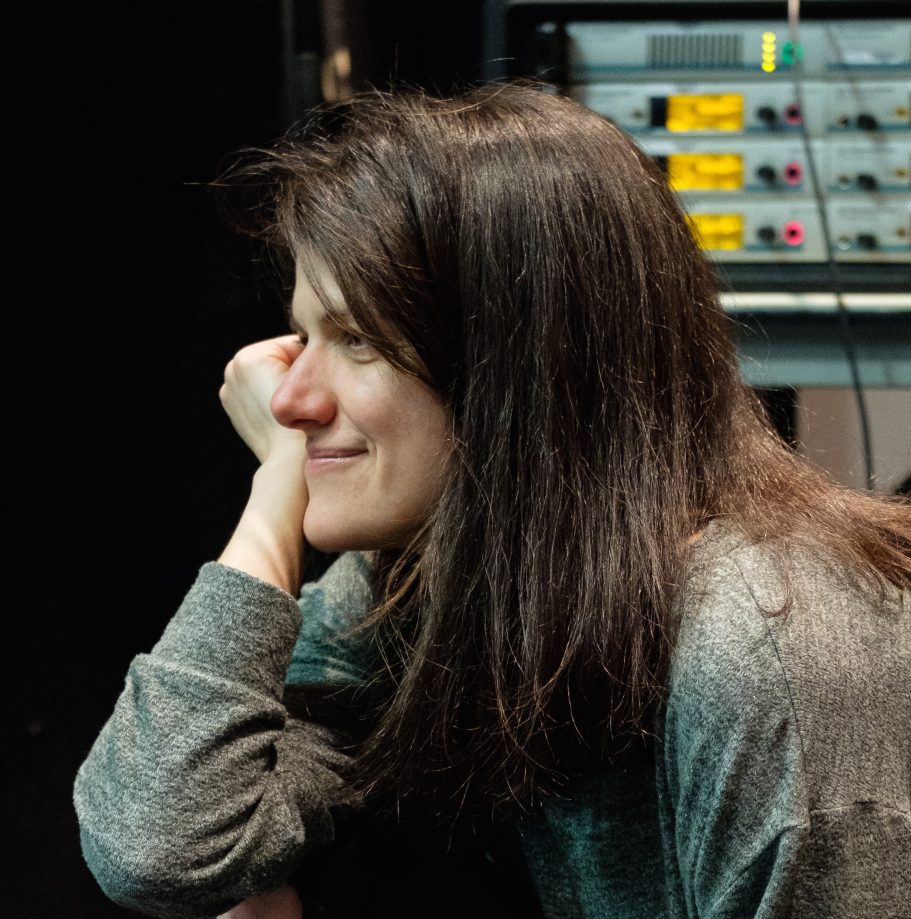De glace: conversation with Anne-Marie Ouellet
Co-founder and co-director of the company L’eau du bain, Anne-Marie Ouellet is a director, theatre professor at the University of Ottawa, and playwright. The unique visual and sound signature of L’eau du bain is reflected in works such as White Out and La chambre des enfants (presented at the FTA in 2023), Solarium, and Le musée de la famille. She reflects on the creation of the show De glace, which will be presented in Vancouver from January 31 to February 2. In this adaptation of the novel The Ice Palace by Norwegian author Tarjei Vesaas, the audience is immersed in a dreamlike universe that promises to engage all our senses.
Photo © Jonathan Lorange
De glace draws its story from the novel The Ice Palace, written by Tarjei Vesaas in 1963, and considered a masterpiece of Norwegian literature. Why did you decide to adapt that novel?
Anne-Marie Ouellet: It’s a beautiful and very mysterious novel. It tells the story of two 11-year-old girls, Siss and Unn, who experience a sudden, intense connection. Is it love? Is it friendship? It doesn’t matter. What matters is that it’s stronger than anything, and it radically transforms them. The age of the main characters is really significant to me. At 11, you’re on a threshold, straddling childhood and adulthood. Things are experienced with an overwhelming intensity. This is the first time we’ve created a show based on a story. We usually draw from various sources of inspiration to offer a non-narrative experience. But Vesaas’s novel is extremely open. It leaves a lot of room for the reader’s imagination. It’s crucial that the audience can dream with us through the performance.
Each of L’eau du bain’s seven works inhabits a world at the crossroads of dreams, defined by sound and light, as well as a remarkable use of space and technology. What is your creative process like? How do you make these elements interact with each other?
A-M. O: Our shows always emerge from a dialogue between our respective mediums, with Nancy Bussières (lighting designer), Thomas Sinou (sound designer), and myself. Since Nancy and I are both University professors and researchers (at UQAM and the University of Ottawa, respectively), we have the luxury of long periods of creative work in the space with the technical equipment. This allows us to create the performance together, integrating all the elements—almost like musicians jamming with our instruments. We start by selecting inspirational materials (textual, visual, sound, etc.), and then we define the scenic setup. We then invite performers to dive in with us into the creation process. Generally, our aim is to create an environment rather than tell a story. The performance gradually takes shape through our stage explorations.
You traveled to Norway to record the sounds heard in De glace… How do you recreate a Norwegian landscape through sound and light?
A-M. O: In the novel, nature takes center stage. We aren’t told much about the characters’ emotions; instead, these emotions are embodied by the transformations in the landscape. Nancy is fascinated by the light in northern countries, by the perceptual distortions caused by a sun that never rises far above the horizon. So, she worked with that line, diffusing light through smoke. She suggests things more than she shows them. Thomas’s sound design immerses us in the heart of the forest, by the edge of a lake. The cracking of the ice penetrates our bodies and makes us feel the cold. By the end of the play, we realize that life is resuming its course as the water starts flowing again in the waterfall and river. Because these sound and light environments are so powerful, we don’t need to narrate where we are or what is happening. The bodies of the audience understand it intuitively.
You often play with sensory stimulation, even leading the audience to lose their bearings. White Out, for example, opened with a storm. For De glace, can you describe what awaits the audience when they enter the theatre?
A-M. O: The audience will be guided to their seats by the characters, as the entire room will be shrouded in mist. They’ll walk along a small snow-covered path, leading them to the forest where Siss and Unn meet. We’ve aimed to preserve the sense of mystery. The light, diffused through the fog, allows us to envelop the audience and take them with us onto a frozen lake at dawn. Headphones will deliver the soundscape, creating a very intimate connection between the audience and the characters. We hear them up close, and the surrounding sound environments fully immerse the audience, as though they’re standing right there with us.
Poetry plays a significant role in Vesaas’s writing. Much is suggested rather than stated outright, and a sense of mystery lingers from start to finish…
A-M. O: Our primary goal is to create a sensory experience, to engage the audience’s senses before appealing to their intellect. We want to draw them into the fictional space, so they can imagine the story in real time. In my view, allowing room for each person’s imagination makes the experience accessible to a wide audience. De glace isn’t a show for children or for adults—it’s for everyone from age 8 and up. And each person is the master of their own experience. The Ice Palace is not a children’s novel, but its main characters are children—children who are taken seriously.
An audio interview between Anne-Marie Ouellet and Gabrielle Martin, Artistic Director of the PuSh International Performing Arts Festival, is also available in English on PuSh Play, the festival’s podcast. The transcript is available on the festival’s website. De glace will be presented from January 31 to February 2 at the Roundhouse Performance Centre, with the PuSh Festival and the Vancouver International Children’s Festival. For more information and tickets, visit the show’s page.

